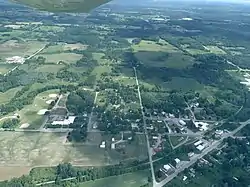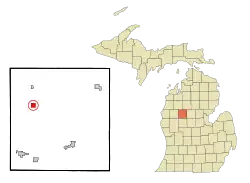LeRoy, Michigan
LeRoy is a village in Osceola County of the U.S. state of Michigan. The population was 256 at the 2010 census. The village is located within LeRoy Township.
LeRoy, Michigan | |
|---|---|
 Aerial of Village of LeRoy, Michigan. July 2017 | |
 Location of LeRoy, Michigan | |
| Coordinates: 44°2′16″N 85°27′10″W | |
| Country | United States |
| State | Michigan |
| County | Osceola |
| Area | |
| • Total | 0.98 sq mi (2.55 km2) |
| • Land | 0.98 sq mi (2.55 km2) |
| • Water | 0.00 sq mi (0.00 km2) |
| Elevation | 1,260 ft (384 m) |
| Population | |
| • Total | 256 |
| • Estimate (2019)[3] | 252 |
| • Density | 256.36/sq mi (99.01/km2) |
| Time zone | UTC-5 (Eastern (EST)) |
| • Summer (DST) | UTC-4 (EDT) |
| ZIP code | 49655 |
| Area code(s) | 231 |
| FIPS code | 26-47100[4] |
| GNIS feature ID | 0630237[5] |
| Website | http://www.leroymichigan.org/ |
History
A post office in LeRoy has been in operation since 1871, with James E. Bevins serving as postmaster from 1871 to 1895.[6] In 1871 S.L. Kimball, M. Westfall and James Bevins settled in the area[7] and the village of LeRoy was incorporated February 2, 1873.[8] The village was named for LeRoy Carr, a land agent representing the federal government in the area.[9][10]
Geography
According to the United States Census Bureau, the village has a total area of 0.97 square miles (2.51 km2), all land.[11]
Demographics
| Historical population | |||
|---|---|---|---|
| Census | Pop. | %± | |
| 1880 | 134 | — | |
| 1890 | 452 | 237.3% | |
| 1900 | 375 | −17.0% | |
| 1910 | 331 | −11.7% | |
| 1920 | 642 | 94.0% | |
| 1930 | 270 | −57.9% | |
| 1940 | 274 | 1.5% | |
| 1950 | 243 | −11.3% | |
| 1960 | 267 | 9.9% | |
| 1970 | 248 | −7.1% | |
| 1980 | 293 | 18.1% | |
| 1990 | 251 | −14.3% | |
| 2000 | 267 | 6.4% | |
| 2010 | 256 | −4.1% | |
| 2019 (est.) | 252 | [3] | −1.6% |
| U.S. Decennial Census[12] | |||
2010 census
As of the census[2] of 2010, there were 256 people, 97 households, and 68 families residing in the village. The population density was 263.9 inhabitants per square mile (101.9/km2). There were 111 housing units at an average density of 114.4 per square mile (44.2/km2). The racial makeup of the village was 96.1% White, 1.6% African American, 0.8% Native American, and 1.6% from two or more races.
There were 97 households, of which 35.1% had children under the age of 18 living with them, 61.9% were married couples living together, 7.2% had a female householder with no husband present, 1.0% had a male householder with no wife present, and 29.9% were non-families. 23.7% of all households were made up of individuals, and 9.3% had someone living alone who was 65 years of age or older. The average household size was 2.64 and the average family size was 3.10.
The median age in the village was 39.6 years. 25.8% of residents were under the age of 18; 7% were between the ages of 18 and 24; 25% were from 25 to 44; 25.8% were from 45 to 64; and 16.4% were 65 years of age or older. The gender makeup of the village was 48.8% male and 51.2% female.
2000 census
As of the census[4] of 2000, there were 267 people, 100 households, and 74 families residing in the village. The population density was 275.1 per square mile (106.3/km2). There were 106 housing units at an average density of 109.2 per square mile (42.2/km2). The racial makeup of the village was 97.75% White, 0.37% Asian, and 1.87% from two or more races.
There were 100 households, out of which 44.0% had children under the age of 18 living with them, 62.0% were married couples living together, 9.0% had a female householder with no husband present, and 26.0% were non-families. 26.0% of all households were made up of individuals, and 13.0% had someone living alone who was 65 years of age or older. The average household size was 2.67 and the average family size was 3.18.
In the village, the population was spread out, with 30.7% under the age of 18, 6.4% from 18 to 24, 30.0% from 25 to 44, 21.3% from 45 to 64, and 11.6% who were 65 years of age or older. The median age was 35 years. For every 100 females, there were 74.5 males. For every 100 females age 18 and over, there were 77.9 males.
The median income for a household in the village was $32,188, and the median income for a family was $40,694. Males had a median income of $27,500 versus $23,750 for females. The per capita income for the village was $13,434. About 4.1% of families and 7.9% of the population were below the poverty line, including 12.6% of those under the age of eighteen and 12.5% of those 65 or over.
Notable people
- Mary E. Byrd, educator and astronomy teacher * probably East LeRoy
- Forest Ray Moulton, astronomer
References
- "2019 U.S. Gazetteer Files". United States Census Bureau. Retrieved July 25, 2020.
- "U.S. Census website". United States Census Bureau. Retrieved 2012-11-25.
- "Population and Housing Unit Estimates". United States Census Bureau. May 24, 2020. Retrieved May 27, 2020.
- "U.S. Census website". United States Census Bureau. Retrieved 2008-01-31.
- U.S. Geological Survey Geographic Names Information System: LeRoy, Michigan
- "Chronicles of LeRoy". LeRoy Historical Society. 1999. p. 4.
- "Chronicles of LeRoy". LeRoy Historical Society. 1999. p. 1.
- "LeRoy Michigan Official Website".
- State of Michigan, Michigan 192nd Legislature (July 17, 1973). "A Concurrent Resolution Commemorating the LeRoy Centennial". Letter to Village Fathers of LeRoy.
- "Chronicles of LeRoy". LeRoy Historical Society. 1999. p. 37.
- "US Gazetteer files 2010". United States Census Bureau. Archived from the original on 2012-01-25. Retrieved 2012-11-25.
- "Census of Population and Housing". Census.gov. Retrieved June 4, 2015.
